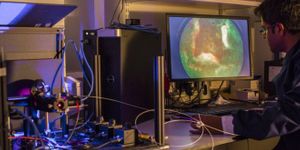Ultra-Thin Bionic Skin: The Next-Generation of Wearables
At first glance, the sheet of electronic resembles a used candy wrapper rather than a sophisticated wearable device. But make no mistake, this simple-looking creation is filled with advanced circuits and sensors that make it one of the thinnest and most flexible wearable healthcare sensors ever invented.
Dubbed the “e-skin,” this newest form of wearable technology is ultra-thin and has micro-electronic components that light up in different colors as it is attached to the body.
Researchers from University of Tokyo are the masterminds behind this stick-on tattoo of the future. The film is constructed out of layers of silicon oxynitrite and parylene, to which they’ve embedded polymer light emitting diodes (PLEDs) and Organic Photodetectors (OPDs). These emit a range of colors, including red, blue, and green. Because it’s stretchable and less than 3 millimeters thick, the ‘e-skin’ can be attached to nearly any surface on the body and withstand hundreds of crumples without compromising its integrity.
As each diode corresponds to a pixel when lit, researchers can arrange many diodes together to form complex and meaningful displays. The team envisions one such application to be sensing the levels of oxygen or pulse rate of a patient while in surgery.
But wait… isn’t there already a technology for that? Indeed, a pulse oximeter is a small device that hooks on to a patient’s finger for the expressed purpose of reading pulse rate and oxygen status. It’s widely used in hospital setting and is even commercially available for home use.
So how is the e-skin innovation any different? The team stresses the e-skin’s wearable feature, which makes it significantly less obtrusive and arguably more reliable. "The device unobtrusively measures the oxygen concentration of blood when laminated on a finger," said Tomoyuki Yokota, first study author. In addition, the electronic skin isn’t limited to any one appendage; rather, it can, theoretically, be attached to pretty much anywhere on the body. "Ultimately, flexible organic optical sensors may be directly laminated on organs to monitor the blood oxygen level during and after surgery," said Yokota.
The device also has the advantage of consuming less power and producing less heat. These properties combined with the durability of the film material, significantly increases the longevity of the device.
"The advent of mobile phones has changed the way we communicate," said Takao Someya, senior study author. “While these communication tools are getting smaller and smaller, they are still discrete devices that we have to carry with us.” He added, "What would the world be like if we had displays that could adhere to our bodies and even show our emotions or level of stress or unease? In addition to not having to carry a device with us at all times, they might enhance the way we interact with those around us or add a whole new dimension to how we communicate."









